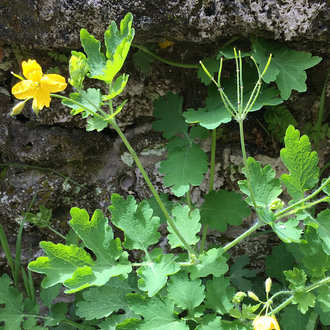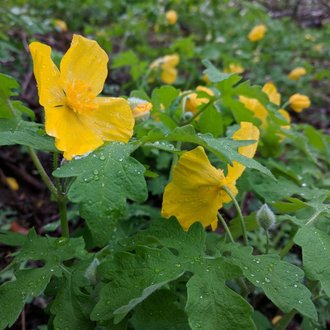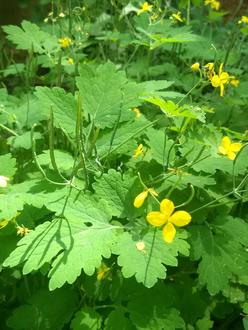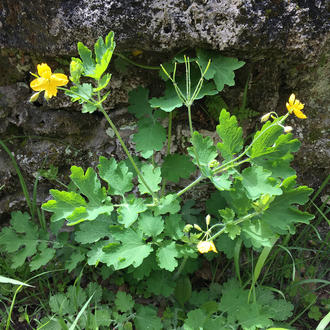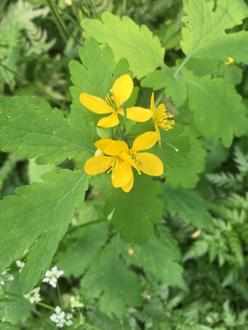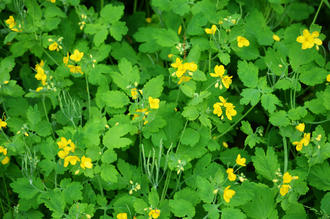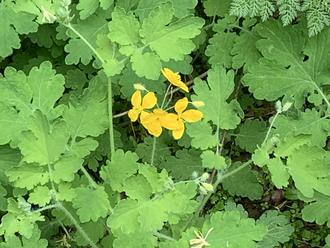Greater Celandine (Chelidonium majus L.)
↑Summary
A bienniel or short-lived perennial native to Europe and nearby, introduced in North America, where it is invasive in cooler, northern areas.
↑Similar Plants
↑Habitat
In its native range, this species is found in woodlands, on rocky slopes, and also in waste areas, along roadsides, gardens, and urban areas. Found in full sun to part shade.
Its habitat preferences in North America seem to be similar, including woodlands, waste areas, and roadsides, as well as gardens and urban areas including parks and semi-wild areas.
This species seems to be restricted to the parts of North America with a cooler climate, and is most common in the northeast, extending into the southern Appalachians at higher altitudes, and it is also fairly widely established in a narrower band throughout the midwest, and has a scattered distribution throughout, including in the northwest, but it is absent from the southern parts of the U.S.
↑Life Cycle
This species is a biennial or, occasionally, a short-lived perennial.
First-year plants grow only a rosette of leaves.
In their second year, plants begin to grow upright, and often branch repeatedly. Growth is upright if supported by other vegetation, or sprawling if not. Plants bloom in summer, typically over a period of 1-2 months. Flowers may be pollinated by insects, but are also self-fertile.
Seed production is incremental, with seed pods beginning to form as the plant is still producing new flowers. Seeds begin ripening in mid summer and continue into early fall. Seeds are distributed by ants.
Seeds begin germinating in the following year, but germination is erratic and gradual, distributed over a long period of time. Seeds may germinate at any time of year, but usually do so during a period of moderate temperatures. This species can persist for over a year in the seed bank, but we could not find research on exactly how long it persists. Its staggered germination period makes it well-adapted to disturbance and able to thrive in habitats that experience irregular, unpredictable disturbances.
Plants do not reproduce vegetatively. They often die after producing seed.
↑Faunal Associations
This plant has low value to wildlife, especially in North America. The flowers produce only pollen and no nectar; they are likely visited by some bees and flies, but not particularly important to these insects. Their seeds are eaten by ants. The foliage and sap is toxic and thus most of the plant is ignored by mammalian herbivores, and probably not favored by insect herbivores either.
↑Control
This plant can be controlled by uprooting plants before they set seed. Plants are shallow-rooted and usually easy to uproot by hand. Care must be taken to wear protective clothing and gloves, as the plant's sap is an irritant.
This species has hydrophobic leaves, and as such does not absorb herbicide well without the addition of a surfactant. Surfactants can be damaging to aquatic life and can also make it more likely that the herbicide will damage surrounding plants. As this plant typically grows together with other, often native plants, and is often found near water, in most cases it is best controlled manually. However, herbicide, with the use of surfactants, can be effective at controlling large monocultures when it is safe to do so.
As this species is a prolific seeder, timing of control is critical, and it is easier to prevent establishment by spotting and pulling individual plants than it is to control this plant once it has become dominant on a site. Once it has gone to seed on a site, it may be necessary to return for several years to fully eliminate it, due to its persistence in the seed bank.
↑Uses
This plant has some uses in traditional medicine. However, it has considerable toxicity and is not generally recognized as safe.
It was historically used as a garden plant but its invasiveness has been known for some time, and its use in gardens has mostly been discontinued, except in the Pacific Northwest where it is still occasionally planted. Double-flower cultivars exist, which have eight petals; both due to these extra petals not hindering pollination, and the fact that these plants are self-fertile, the double-flower trait can sometimes persist in wild populations.
↑Related Plants
This species is the only member of its genus in North America, but there are other members of the broader Chelidonieae tribe. On this continent, its closest relative is the native and visually-similar celandine poppy (Stylophorum diphyllum), and it is not particularly closely related to the other members.
↑Links & External Resources
• Chelidonium majus (Greater Celandine) | Illinois Wildflowers (About This Site)
• Chelidonium majus (Greater Celandine) | USDA PLANTS Database (About This Site)
• Chelidonium majus | Go Botany (About This Site)
• Chelidonium majus (Greater Celandine) | Missouri Botanical Garden Plant Finder (About This Site)
• Chelidonium majus | Biota of North America Project (BONAP) (About This Site)
• Chelidonium majus | NatureServe Explorer (About This Site)
• Chelidonium majus | Flora of North America (About This Site)
• Greater Celandine | Maryland Biodiversity Project (About This Site)
• Chelidonium majus (Celandine) | Minnesota Wildflowers (About This Site)
• Chelidonium majus L. (Greater Celandine) | Digital Atlas of the Virginia Flora (About This Site)



